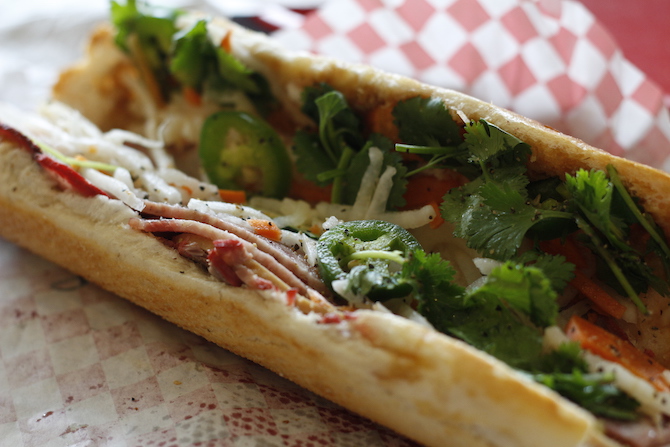One of the thoughts that pop into my mind as I order the “Chinese chicken salad” I’m going to take home for dinner is that I hope my server doesn’t see me and try to draw a connection between my choice of salad and my race. In my head, I argue, “Yes, I am Asian. No, that has nothing to do with the fact I ordered the salad that claims to be ‘Chinese’ on the menu.”
Yup, it’s as ridiculous as it sounds.

GIF courtesy of giphy.com
Less ridiculous are the thoughts I have as I sit down and start to stab at the pieces of chicken and greens in my plastic take-out bowl. First of all, what does the label “Chinese” even have to do with the salad I’m eating? Is it the fact that the ingredients of the dressing include sesame oil and soy sauce? Is it because of the canned mandarin oranges that limply sit between the layers of lettuce? I pause for a moment in disappointment as I realize that I’m literally consuming a form of cultural appropriation.
Recently, students at Oberlin College came to similar conclusions with the food served at their dining halls. Although the offerings were inspired by good intentions (hello, cultural diversity), my peers at Oberlin found their dining halls to be serving heavily misrepresented versions of cultural dishes. In response, national media outlets have picked up the news, some being quick to add a disparaging note to the student actions and aligning it with the trending argument about university students that are too sensitive and overly concerned with political correctness.

GIF courtesy of giphy.com
The food itself isn’t the disappointing part. My salad’s delicious (but I can’t vouch for dining hall food). What’s disappointing is how easy it is to slap a cultural descriptor to a food item that’s vaguely inspired by the culture it’s named after. If you think about it, the “Chinese” or “Oriental” chicken salads you encounter every so often at different eating establishments has very little to do with China, Chinese food, or even Asia as a whole.
The issue at hand isn’t complicated. Simply put, why label a dish as being a cultural element when it’s not? In Oberlin College’s case, a bánh mì-esque sandwich is merely a pork sandwich, while my “Chinese chicken salad” is just a chicken citrus salad. Shocked? Don’t be.

GIF courtesy of giphy.com
The underlying implications of cultural mislabeling are bigger. Misrepresenting cultural dishes can, yes, feel like a slap in the face to some. Food is an important part of any culture, both rich with historical and, for those who have grown up within a certain cultural background, with familial associations. Misrepresentations of cultural foods is just the beginning of how food can result in mishandling of culture, such as the growing trend of restaurants serving cultural foods that may have brought wrinkled noses and gags of disgust in the not-too-distant past.
Although it may require some conscious effort as we increasingly continue to consume and glamorize ethnic foods, it is possible to both enjoy what we eat and respect where it comes from. Americanized Asian food can be an amazing guilty pleasure and, chances are that the plate of pasta you order at the neighborhood Italian restaurant or your mom’s spaghetti is going to be pretty damn different from what an Italian restaurant in Italy will serve you.
However, there’s a fine line between appropriating cultural food and creating something entirely new and amazing out of it, like the tacos served out of Roy Choi’s infamous Kogi trucks – especially if the cultures in question have a history of being socially marginalized.

Photo by Vicky Nguyen
Sure, maybe Oberlin’s students are making an argument about cultural appropriation when it’s really just the shitty quality of dining hall food they should be being critical about. But why should we have to settle for shitty dining hall foods, much less the poor attempts at making these foods culturally diverse?
Regardless of whether it’s through sub-par dining hall food or bougie menu items from “that one really popular place,” the way we serve up cultural foods is all a part of how we perceive and reinforce the role of different cultures within our communities.

GIF courtesy of giphy.com
So what should we do? Go seek out and experience all the food. When you get the chance, try everything – whether it’s in the various cultural enclaves scattering giant cities like LA or NYC, the local mom and pop shops with the immigrant owners who lovingly dish up their favorite home-country dishes, or the innovative establishments serving the coolest mash-ups of foreign dishes you’ve never heard of.
But most importantly, as you do so, make sure to seek out the stories behind these foods. Whether it’s by dragging your friend who’s grown up eating what’s on the menu with you to dinner or by doing a quick Google search on your smartphone, there’s no end to what you can learn.
Lastly, don’t feel obligated to settle for bad bánh mì. Now, let’s go eat.

GIF courtesy of giphy.com


